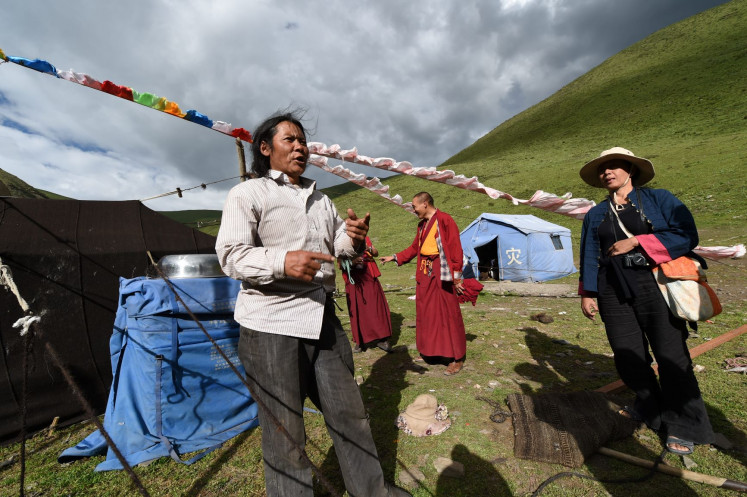Popular Reads
Top Results
Can't find what you're looking for?
View all search resultsPopular Reads
Top Results
Can't find what you're looking for?
View all search results‘Art at a Time like This’ goes online during pandemic
Indonesian prominent artist Arahmaiani Feisal joins a show that swiftly responds to the ongoing health crisis by taking the exhibition online.
Change text size
Gift Premium Articles
to Anyone
A
t the time when galleries and museums close their doors to slow down the pandemic, a show, aptly called “How Can We Think of Art at a Time Like This?”, goes online to respond to the crisis.
The show raises the big question in the back of people’s mind at a time when the pandemic is wreaking havoc and bringing the world to a standstill, not only closing down galleries and museums and putting art events on hold but also clearing many artists of their busy schedule.
Two women behind the online show, writer-curators Barbara Pollack and Anne Verhallen, set up the online platform artatatimelikethis.com to showcase the works, while at the same time, using it as a media to exchange ideas and open a dialog at a time of physical distancing.
“Art offers solace or has instigated resistance and rebellion. This was true during the AIDS crisis, in the weeks after 9/11, at the shock of Hurricane Sandy and all the other signs of global warming altering environments around the world,” the curators said.
For the ongoing show, the curators invited artists who are considered thought leaders, artists who struggle with futuristic pessimism, political outrage and psychic meltdowns. The invited artists have responded with unbridled enthusiasm.
Prominent Indonesian artist Arahmaiani Feisal was invited to join the show’s lineup of international artists, which include China Marks, Kathe Burkhart, Martha Wilson, Rachel Rossin, Will Benedict and Zhao Zhao. The curators plan to add artwork by new artists every day, with Ai Weiwei and Shinique Smith reportedly among those on the list.
Each artist submitted around five pieces, including videos, to the platform, which is not a commercial one or aims to serve as a fundraiser, but according to curators, it is purely “a place of exchange, a place to vent or cry, share anxieties or plan a revolution”.
Arahmaiani, who herself submitted her community-based art project in Tibet Plateau, told The Jakarta Post that she knew Pollack when holding her solo exhibition at Tyler Rollins Gallery in New York, the United States. The gallery then reconnected her with the curator for the latest show.
Arahmaiani is one of Indonesia’s most seminal and respected contemporary artist, who consistently focuses on working with communities and dealing with cultural, social, political and environmental issues both at home and abroad in the span of her nearly three decades of artistic career.
Her art is not only done in studios but also with communities in various places in in Java and Bali, as well as in other countries like Australia, Canada and Germany and the Tibet Plateau in China.
For the online show, Arahmaiani is putting the focus on her project held in the Tibet Plateau, where she worked in the Kham area in 2010 after the area was hit by an earthquake.
She said the reason she went to the plateau in the first place had to do with her participation at an exhibition at the Shanghai Contemporary Art Museum. The exhibition’s curator selected her for her community-based art project, prompting her to ask for an opportunity to work with communities in China.
“I realized this kind of art [at the time] in China was not a common practice, so I wanted to show audience what that meant,” Arahmaiani says.
At that time, she was looking to work in a marginalized community or a community that was hit by a disaster. She chose Yushu prefecture because it had been hit by an earthquake. Armed with experience working with earthquake victims back home in Yogyakarta and accompanied by a Chinese artist, Arahmaiani went to Yushu to see if she could help.
“As we didn't know nobody, I decided to go and find a monastery,” she says.
From then on, her project evolved, and in the first five years, she and the monks from a monastery created a garbage management and recycling project, planted trees and revived organic farming practices. They later got support from the Chinese government, allowing them to reach more villages and expand the project.
The multitalented artist is aware that at the time of the pandemic when people have to stay at home to stem the virus’ spread, it has also changed the way people and artist like herself go about their work.
With the pandemic still in full swing, she is aware how the situation limits activities with communities but insists that community-based art practices are very relevant to the current situation as they encourage people to work together.
“They [curators] think that community-based practices and an environmental focus are needed today,” she says.
“My work in Tibet in the past 10 years is considered as a good example that needs to be expanded into many other communities. And I completely agree.”
Arahmaiani is currently in Bali for her art residency at Tony Raka gallery ahead of her upcoming exhibition scheduled in July — if the crisis subsides. She is also collaborating with the gallery to work with communities in Bali.
She said art offers creative solutions to deal with the negative impacts and serious implications of the pandemic.
“Art is a creative medium that is very flexible and can respond to any condition and situation. Art can provide inspiration to find alternative and creative solutions to problems.”












